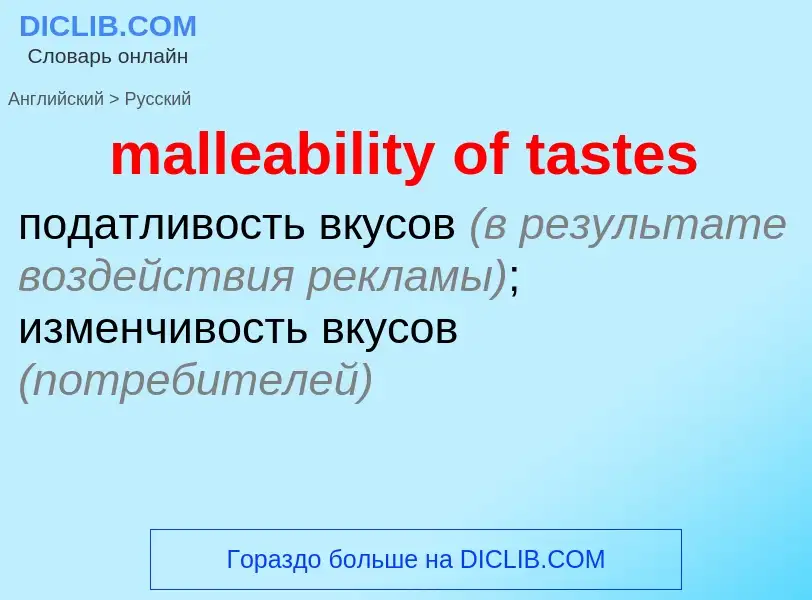Перевод и анализ слов искусственным интеллектом ChatGPT
На этой странице Вы можете получить подробный анализ слова или словосочетания, произведенный с помощью лучшей на сегодняшний день технологии искусственного интеллекта:
- как употребляется слово
- частота употребления
- используется оно чаще в устной или письменной речи
- варианты перевода слова
- примеры употребления (несколько фраз с переводом)
- этимология
malleability of tastes - перевод на русский
общая лексика
вкус
['saunis]
общая лексика
кисловатость
существительное
общая лексика
кислота
кислый вкус
химия
кислотность
[teist]
общая лексика
вкус
вкусовое ощущение
ощущать вкус
дегустировать
ощущение
привкус
проба
пробовать
чувствовать
существительное
[teist]
общая лексика
вкус (чувство)
вкус
понимание
такт
склонность
влечение
пристрастие
стиль
манера
проба
глоточек
кусочек
немного
чуточка
примесь
привкус
представление
образчик
кухня
набор национальных блюд
склонность, пристрастие
вкус, понимание
манера, стиль
немного, чуточку
кусочек, глоточек (на пробу)
первое знакомство (с чем-л.)
устаревшее выражение
опробование
глагол
общая лексика
пробовать
отведать
дегустировать
иметь вкус
иметь привкус
отдавать (чем-л.)
различать на вкус
чувствовать вкус
есть
пить (особ. немного)
вкушать
испытывать
получать представление
знакомиться
(of)
содержать в себе элемент (чего-л.)
отдавать
чувствоваться
иметь вкус, привкус
устаревшее выражение
откушать
склонность
устаревшее выражение
вкусить
познакомиться
испытать
познать на своём опыте
редкое выражение
придавать вкус
в переносном значении
вкусить, испытать
['sɔ:ltinis]
общая лексика
соленость
солоноватость
существительное
общая лексика
вкус соли
солёность
медицина
вкусовое ощущение
['sauə]
общая лексика
кислый
сауэр, лимонный коктейль (из джина или виски с лимонным или лаймовым соком, кусочком апельсина и т.п.)
высокосернистый
заквашивать
закисать
закиснуть
закисший
квасный
кислеть
сернистый
скисать
скиснуть
нефтегазовая промышленность
содержащий сероводород
синоним
Смотрите также
прилагательное
['sauə]
общая лексика
кислый
прокисший
свернувшийся (о молоке)
недовольный
в дурном настроении
мрачный
разочарованный
неудачный
неудовлетворительный
плохой
отвратительный
неприятный
угрюмый
кислый, болотистый (о почве)
Шотландия
промозглый (о погоде)
сельское хозяйство
сырой
болотистый (о почве)
химия
подкислённый
сернистый (о нефтепродуктах)
музыка
фальшивый
фальшивящий
синоним
антоним
наречие
['sauə]
общая лексика
мрачно
неприятно
существительное
['sauə]
общая лексика
кислятина
кислый раствор (при отбеливании, дублении)
американизм
«сауэр»
лимонный коктейль
глагол
общая лексика
скисать
закисать
прокисать
заквашивать
становиться мрачным
мрачнеть
быть недовольным
раздражать
озлоблять (кого-л.)
портить
гноить
закисать, прокисать
озлоблять(ся)
химия
окислять
Определение
.
Википедия
Taste is the sensation and/or perception of flavors.
Taste may also refer to:



![Al-Mg-Si alloy]]. The local necking and the cup and cone fracture surfaces are typical for ductile metals. Al-Mg-Si alloy]]. The local necking and the cup and cone fracture surfaces are typical for ductile metals.](https://commons.wikimedia.org/wiki/Special:FilePath/Al tensile test.jpg?width=200)

